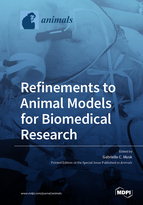Refinements to Animal Models for Biomedical Research
A special issue of Animals (ISSN 2076-2615). This special issue belongs to the section "Veterinary Clinical Studies".
Deadline for manuscript submissions: closed (31 July 2020) | Viewed by 55945
Special Issue Editor
Interests: analgesia; pain; production animals; cattle; sheep; pigs; poultry
Special Issues, Collections and Topics in MDPI journals
Special Issue Information
Dear Colleagues,
The value of publications focused specifically on refinement of animal models in biomedical research is immense. Relying on authors to report their science and include adequate details on methodology, adverse events and outcomes for animals used in biomedical research is unlikely to uphold the 3Rs (refine, reduce, replace) of animal research. Despite the aims of the ARRIVE (Animals in Research: Reporting in vivo Experiments) guidelines published in 2010 and revised in 2019, there is still room for improvement in the level of detail included in publications 1, 2. As examples, details on husbandry, anaesthesia, analgesia, post-procedural monitoring, morbidity and mortality are often scant and therefore make efforts at refinement of models more challenging.
Refinement refers to optimizing the welfare of research animals by avoiding or minimising pain, fear and distress and by maintaining animals in conditions that promote their health and well-being 3. Key contributors to efforts at refinement include anaesthesia, analgesia and post-operative care of animals. Ultimately, refinements should achieve improvements in animal welfare and quality of science.
We invite submissions describing efforts at refinement to animal models to increase the evidence base and to identify and explore opportunities for improving animal welfare and the quality of science.
- Kilkenny C, Browne WJ, Cuthill IC, et al. Improving Bioscience Research Reporting: The ARRIVE Guidelines for Reporting Animal Research. PLOS Biology 2010; 8: e1000412. DOI: 10.1371/journal.pbio.1000412.
- Percie du Sert N, Hurst V, Ahluwalia A, et al. The ARRIVE guidelines 2019: updated guidelines for reporting animal research. bioRxiv 2019: 703181. DOI: 10.1101/703181.
- Prescott MJ and Lidster K. Improving quality of science through better animal welfare: the NC3Rs strategy. Lab Anim (NY) 2017; 46: 152-156. 2017/03/23. DOI: 10.1038/laban.1217.
Dr. Gabrielle Musk
Guest Editor
Manuscript Submission Information
Manuscripts should be submitted online at www.mdpi.com by registering and logging in to this website. Once you are registered, click here to go to the submission form. Manuscripts can be submitted until the deadline. All submissions that pass pre-check are peer-reviewed. Accepted papers will be published continuously in the journal (as soon as accepted) and will be listed together on the special issue website. Research articles, review articles as well as short communications are invited. For planned papers, a title and short abstract (about 100 words) can be sent to the Editorial Office for announcement on this website.
Submitted manuscripts should not have been published previously, nor be under consideration for publication elsewhere (except conference proceedings papers). All manuscripts are thoroughly refereed through a single-blind peer-review process. A guide for authors and other relevant information for submission of manuscripts is available on the Instructions for Authors page. Animals is an international peer-reviewed open access semimonthly journal published by MDPI.
Please visit the Instructions for Authors page before submitting a manuscript. The Article Processing Charge (APC) for publication in this open access journal is 2400 CHF (Swiss Francs). Submitted papers should be well formatted and use good English. Authors may use MDPI's English editing service prior to publication or during author revisions.
Keywords
- 3Rs
- animal model
- refinement
- animal welfare







